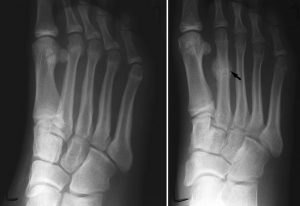You finally decide you are going to get back running after 2 years off and gaining a few kilos. You head out the door in your old worn-out runners and start pounding the pavement everyday to try and get back into shape.
Couple that with cutting out the junk food and going on a low calorie diet you start feeling great. Then you start getting a persistent pain in your foot that is getting worse, you go to your podiatrist and find out you have a stress fracture. A combination of an over eagerness to start a new fitness regime plus significantly reducing your caloric intake can lead to the development of a stress factor.
 Stress fractures develop as a result of overloading hard tissues beyond that which they can repair and adapt. Stress fractures can be caused by a number of both intrinsic and extrinsic factors and
Stress fractures develop as a result of overloading hard tissues beyond that which they can repair and adapt. Stress fractures can be caused by a number of both intrinsic and extrinsic factors and
are more prominent within the female athletic population. The reason for this is generally found in what is known as the Female Triad which incorporates the following three risk factors; Low Bone Density, Hormone Changes (menstrual disturbance) and malnutrition. However, injuries do not discriminate and males are not immune to stress fractures, with a number of extrinsic risk factors contributing to this injury including; the type and duration of activity, footwear choices, recovery time, training surface and history of previous injury all playing a significant role.
The good news is that it is still possible to maintain fitness through the rehabilitation process with cycling, swimming, water running and the elliptical trainer all potential training mechanisms
while suffering from a stress fracture. The time frame for recovery of a stress fracture is highly based on the position and degree of the stress fracture and whether it is identified as HIGH or LOW risk. Non-weight bearing bones are more likely to heal in a faster time frame than those which weight bear.
The best way to treat stress fractures is to prevent them from occurring in the first place. By ensuring you gradually increase your training load, ensure you have the right running shoes and they are frequently replaced, good running technique/form and having a balanced diet you can considerably reduce your risk. We can’t tell you what you should or shouldn’t be eating but we can certainly assess you running and determine if you need to work on improving your biomechanics and give you advice on the types of shoes you should be wearing.
If you are suffering from this frustrating condition, we are here to help! We see hundreds of cases of this condition per year and achieve excellent results for our patients!

